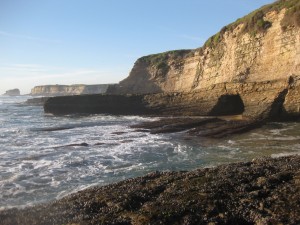Our research aims to better understand the processes that generate and impact the incredible biodiversity that exists on this planet, particularly in the contexts of complex natural ecosystems and rapidly changing climate conditions. To make connections between genes, phenotypes and the environment, we integrate genomics, population genetics, developmental biology, physiology, and ecology using natural populations in both field- and lab-based investigations. Conceptually, our research addresses integrative questions in evolutionary biology, ecological genomics, and global change biology.
Our models systems to explore these questions are sea urchins, copepods, and sea stars. Sea urchins allow the investigation of fundamental physiological phenotypes that are particularly important in the context of climate change; copepods are fundamental to the function of ocean ecosystems and are easy to maintain in the lab across many generations; sea stars, the keystone species from which the concept was defined, have recently experienced the largest marine epidemic in history and the cause is as of yet unknown.
Research themes:
Genetic and physiological mechanisms of resilience to global change
Global conditions are changing at a geologically unprecedented rate, yet there is much more to learn about if and how species will persist into the future. We use sea urchins and copepods as models for these studies because urchins are ecosystem engineers and bellwethers for the impacts of ocean acidification as calcifying organisms while copepods are the critical trophic link between primary producers and important fisheries and are important mediators of marine biogeochemical cycling. The small size of sea urchin larvae and their amenability to lab culture has allowed us to pioneer an approach for detecting adaptive genetic variation using single generation selection experiments (PNAS, 2013). For copepods, their rapid generation time (3-4 weeks) has allowed us to do multi-generation selection experiments.
We are using a range of sea urchin species, environmental stressors, field collections, and single-generation selection experiments in the lab to reveal the genetic and physiological mechanisms that shape sea urchin resilience to global change conditions. In addition, we are validating the putative adaptive role of genetic variation through functional studies using site directed mutagenesis and biophysical protein modeling. [NSF RII 1736253]
We are using multi-generation selection experiments to reveal the genetic and epigenetic mechanisms of adaptation to high temperature and CO2 in copepods. We are also addressing a range of other questions in copepods including: What are the costs and consequences of adapting to multiple concurrent or sequential stressors? How does loss of genetic diversity that occurs with rapid evolution affect resilience and how does this effect depend on the genomic architecture of the trait(s) under selection? [NSF Bio. Oce. 1559075]
Mechanisms of resilience and resistance to Sea Star Wasting Disease
Disease outbreaks are another major threat in marine ecosystems and are increasing in magnitude and frequency. The most recent outbreak of Sea Star Wasting Disease (SSWD) is one of the largest marine epizootics in history but the host-associated microbial community changes and the host physiological responses specific to SSWD progression are unknown. Our work tests for an interaction between host genotype and physiological phenotype, and the microbiome in organisms that are susceptible and resistant. We are addressing these questions in three sea star species that differ in susceptibility and with a combination of experimental time-course infections in the lab and field sampling. [NSF IOS 1555058]
Plastics in the Ocean
Plastics and the compounds they leach are increasingly abundant in the Earths’ oceans. Kate Huber and Emily Shore, an undergraduate honors thesis student and an accelerated masters student, respectively, have designed and led studies on the impacts of plastics on organismal development, fitness, and survival. Kate has tested the effects of four previously unstudied plastic leachates on larval sea urchin growth, development and survival. Emily is studying the impacts of microplastics on copepod fitness and behavior.
Ecological genomics in emerging model organisms
We also have a number of collaborative projects including with Tyler Evans at CSU East Bay on selection and resilience to extreme low salinity events in oysters. We have identified the physiological mechanisms underlying extreme low salinity tolerance, mimicking large  storm events, among locally adapted Olympia oyster populations (Mol. Ecol., 2018); we have generated genomic resources for the ecologically and economically important pan-tropical collector sea urchin, Tripneustes gratilla (Mar. Genomics, 2018). We have also highlighted the broad utility of genomic approaches for characterizing adaptive genetic variation and physiological phenotypes (Mol. Ecol., 2015).
storm events, among locally adapted Olympia oyster populations (Mol. Ecol., 2018); we have generated genomic resources for the ecologically and economically important pan-tropical collector sea urchin, Tripneustes gratilla (Mar. Genomics, 2018). We have also highlighted the broad utility of genomic approaches for characterizing adaptive genetic variation and physiological phenotypes (Mol. Ecol., 2015).
Adaptive evolution across environmental mosaics
A common assumption in evolutionary biology has been that widely distributed, highly dispersing species are rarely adapted to local environmental conditions, as local selection tends to be swamped by gene flow. Our work has demonstrated the contrary; there are many signals of local adaptation across the genome of the purple sea urchin, a highly dispersing marine invertebrate whose species range spans from the cold waters of Alaska to the warmer waters of Baja California, Mexico.